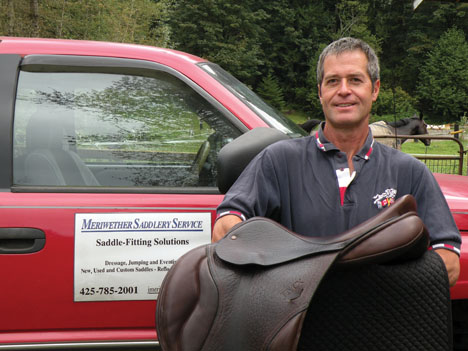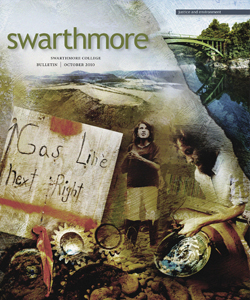The Perfect Fit
John Meriwether ’82 finds a second career as a horse’s tailor.
 The story of how John Meriwether ’82 became a professional saddle fitter has roots in diplomatic exchange.
The story of how John Meriwether ’82 became a professional saddle fitter has roots in diplomatic exchange.
When Meriwether resigned from the Foreign Service after five years and assignments in Canada and Hungary—“My wife and I had a prenuptial agreement that it wouldn’t be a career,” he jokes—he had certain conditions for his next job. “I had to find something that was fun, that I would enjoy as much as the State Department.”
“In Canada, I met this guy who makes saddles, and he told me if I ever wanted to work with him, he’d be happy to have me. I have an M.B.A. so he was thinking more along the lines of me working in his office and I thought, no, I don’t want to be an office worker.”
Instead, Meriwether became a saddle fitter, someone who takes saddles apart to make them better fit their wearers. “Most saddles are sold off the rack, but most horses aren’t made off the rack,” Meriwether explains. Like humans, they are dominant on either the right side or the left; for some, their withers are higher than their behinds and others are built the other way around.
“They’re not all made to one mold, and when we consider them as athletes, like any athlete, the more they exercise, the more you train them, the more their muscles develop in different ways. So the saddle you bought yesterday may not work next month.”
Or by way of analogy, “Imagine you bought a new suit. You start going to the gym, you start working with a personal trainer. The personal trainer helps you build strength and then the suit doesn’t fit anymore. You can sell the suit or have a tailor alter the suit for you. I’m the tailor.”
Meriwether initially worked for the saddle maker he met in Canada, Jochen Schleese, but now runs his own company, the Meriwether Saddlery Service. His fees range from $140 for a consultation to another $115 to $400 for saddle repair, and he travels throughout the West from his home in Issaquah, Wash., visiting horse farms and giving clinics. His clients range from novice equestrians to Olympians. In a typical repair job, he adjusts the frame of the saddle—“the tree”—or “reflocks” the wool padding underneath, or both. He occasionally makes a custom saddle, casting people’s butts in plaster and sending the mold off to the shop.
When a saddle doesn’t fit properly, Meriwether explains, the horse and rider’s performance suffers—and often the rider doesn’t even know it. “A lot of times, horses are slow to tell people that the saddle doesn’t fit them anymore, or a rider has no idea that the horse’s performance is less than optimal.”
“The saddle should be something that enhances—not hinders—the communication between horse and rider,” Meriwether says.
Meriwether is a long-time rider himself. He lives on a five-acre farm with his wife, Jan, a health care administrator; their two children, Hayden, 18, a freshman at the University of Oregon, and Julia, 16, a high school junior; and two thoroughbreds, former race horses.
“Neither horse was very good in their first career, but they are excellent in their second career, which is three-day eventing,” Meriwether says. He competes at the preliminary level—the first level of international competition—in the three-part sport, composed of contests in dressage (in which horse and rider are judged on the precision of their movement, and which has been likened to “horse ballet”), cross-country jumping, and show jumping.
Meriwether also designed and sells his own brand of saddle—the JMX Jumping and Event saddle. “I look at it as a problem-solving saddle,” he says. “I got rid of all the things that people have been asking me to fix over the years.”
So, the verdict: Is saddle fitting as much fun as his previous career? “It’s not as exciting as being in the Foreign Service. When you have something exciting going on in the Foreign Service, it’s a coup, it’s an earthquake, it’s a meeting of heads of state. So I don’t get that,” Meriwether says. “But I do work with horses every day. There are so few opportunities to work in the horse world, I’m just very happy to be one of those people who’s living the dream.”
—Elizabeth Redden ’05
 Email This Page
Email This Page